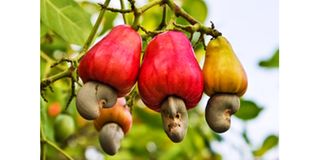Tanzania seeks to reach new record cashew yields target

Domestic value-addition to the crop would benefit Tanzanians
What you need to know:
- Government aims at increasing the use of sulphur powder, liquid pesticide and motorised sprayers following evidence that increased application of the chemicals on cashew trees is significant in increasing raw cashew nut yields.
Dar es Salaam. The government has started distributing subsidised inputs to cashew farmers in its efforts to meet its target of producing 400,000 tonnes in the next season and 700,000 tonnes by 2025.
Government aims at increasing the use of sulphur powder, liquid pesticide and motorised sprayers following evidence that increased application of the chemicals on cashew trees is significant in increasing raw cashew nut yields.
A guideline for provision of subsidised inputs released by the Cashewnut Board of Tanzania (CBT) shows an increasing trend of inputs application in the last ten years between 2012/13 and 2021/22 from 5,000 tonnes to 13,562 tonnes respectively.
The document says as a result, raw cashew nut yields gradually increased from 127,947 tonnes to 238,576 tonnes in the said years.
According to the guideline, at least 45,000 tonnes of sulphur powder; 2.5 million litres of liquid inputs, over 10,000 motorised blowers and 4.4 million empty sacks would be required for application on cashew trees in the 2022/23 season.
However, the government is only able to procure and provide 25,000 tonnes of sulphur powder, 1.5 million litres of liquid pesticides and 3,500 motorised sprayers through the CBT.
Tabling the 2022/23 budget in Parliament, agriculture minister, Mr Hussein Bashe said Sh59.3 billion will be used by CBT for the procurement of subsidised inputs for next season.
“The decision is in line with crop utilisation of own funds procedure through the stakeholder’s fund,” Mr Bashe told the Budget House.
The guideline says the exercise will be coordinated by a collective committee of stakeholders and cooperative unions including the Masasi and Mtwara Cooperative Union (Mamcu), Tandahimba and Newala Cooperative Union (Tanecu), Ruangwa, Nachingwea and Liwale Cooperative Union (Runali) and Lindi Mwambao Cooperative Union (LMCU).
Others are Tunduru Agricultural Marketing Cooperative Union (Tamcu), Coast Region Cooperative Union (Corecu), the Tanzania Cooperatives Development Commission (TCDC), CBT, Tanzania Agriculture Research Institute (Tari)-Naliendele and the Tanzania Plant Health and Pesticide Authority (TPHPA).
The guideline names successful bidders for procuring and supplying inputs as Suba Agro; Bens Agrostar; Prosperity; Faham Africa; JM Traders; Bambana and Mo Green.
Quality control and assurance
In order to control the quality and packaged quantity, the responsible committee has prepared a bonded warehouse in Mtwara Region for preserving the inputs under the supervision of ACE Global Company Limited.
“TPHPA will take samples from consignments of procured inputs and release approved chemicals for farmers’ application in their respective cashew trees,” reads part of the document.
Raw Cashew Nut production during the 2021/22 season was used to determine input distribution among growing regions and councils. This time the number of cashew trees available in new cashew growing regions will be the criteria, according to the guideline.
Furthermore, the guideline says traditional cashew growing regions of Mtwara, Lindi, Ruvuma, Coast and Tanga will receive all the 25,000 tonnes of powder sulphur and 98 percent of liquid pesticide/inputs.
According to the guideline, new growing regions will be given only two percent of watery pesticides.
Mtwara, which produced 130,296.92 tonnes in the 2021/22 season, which is equivalent to 54.7 percent of all produced cashews will receive 13,678.35 tonnes of sulphur powder and 806,163 litres of different types of pesticides.
Other cashew growing regions and amount of powder sulphur as well as liquid pesticide in brackets are Lindi (6.929.32 tonnes/435918 litres), Coast (1,665.17 tonnes/275,379 litres); Ruvuma (2,649.92 tonnes/155,656 litres) and Tanga (77.242 tonnes/4,553 litres).
Inputs distribution to farmers
According to the guideline, regional inputs committees will receive their share of chemicals from the distribution team led by TPHPA and distribute them to respective district inputs committees.
The district committees will respectively distribute the chemicals to the wards that will be obliged to take them to villages.
“The village pesticides committee will distribute the inputs to farmers on condition that their farms should be clean. They should also be able to provide an actual number of their cashew trees,” reads the guideline paper in part.
“Also, farmers should be recognised by other village members. They should be ready to accurately and safely use the inputs by adhering to instructions given by ward or village extension officers,” reads another part of the document.
Furthermore, farmers will be required to abide by directives given by district inputs committees aimed at increasing efficiency.
Monitoring and evaluationThe guideline demands the formation of a taskforce in every region that will be responsible for monitoring and supervising inputs distribution in each area.
The taskforce should constitute members of the regional secretariat as well as defense and security committee.
These will be required to hold monthly evaluation sessions throughout the distribution period.
“While inputs will be distributed to farmers for free as a subsidy, the farmers will be required to pay half the price of motorised blowers through special accounts provided by cooperative unions,” reads part of the directive.
According to Mamcu general manager, Biadia Matipa, the distribution exercise is going on smoothly despite earlier challenges including shortage of documents used for recording farmers’ information.
“Apart from receiving more books yesterday (Thursday), the good thing this season is that the inputs have been distributed at the required time,” says Biadia.
LMCU general manager, Nurudin Swallah says the exercise to distribute 110 tonnes of sulphur powder and 97,000 litres of liquid pesticides that they received is progressing well.
“High transportation cost from the main warehouse in Mtwara to the villages is a challenge we have so far encountered given our budgets ...and expectations,” he says.




